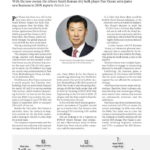With the new owner, the reborn South Korean dry bulk player Pan Ocean anticipates
new business in 2019, reports Patrick Lee
Pan Ocean has been on a roll in the four years after a new owner pulled South Korea’s largest dry[ds_preview] bulk shipping company from the brink. The company is now controlled by South Korean agribusiness Harim Group, which acquired Pan Ocean in 2015. Since then, Pan Ocean, which suffered through the global financial crisis of 2008, has been in the black.
During a meeting with HANSA, a Pan Ocean representative detailed the company’s investment strategy for 2019.
The company’s long-term consecutive voyage charters with Brazilian miner Vale have been well documented. In 2017, Pan Ocean was one of several ship owners that won such CVCs for Vale, pursuant to which, six 325,000 dwt very large ore carriers were commissioned at New Times Shipbuilding in China, for delivery by September 2021.
On 28 January, Pan Ocean announced it would acquire two Capesize newbuildings from an undisclosed shipyard for nearly 107mill. $ to service another Vale contract, which involves transporting 8.12mill. t of iron ore for five years from late 2020. Concurrently, the company is servicing a 21-year CVC that was inked in September 2009, to transport 238.4mill. of iron ore.
Besides the Vale deals, Pan Ocean is optimistic about the medium to long-term outlook for the dry bulk market, and is looking to charter in a few ships for several years.
The company’s representative said that discussions are underway with Japanese tonnage providers Mitsui & Co and Itochu. From Mitsui & Co, Pan Ocean is considering chartering two 63,000 dwt bulk carriers that are to be built by Imabari Shipbuilding in the third quarter of 2019. Pan Ocean is also discussing chartering a 61,000 dwt bulk carrier that will be built by Nantong COSCO KHI Ship Engineering in the first half of 2020. »If all goes well, the ships would be fixed for five to seven years,« he said.
In line with the South Korean government’s promotion of liquefied natural gas as a marine fuel, Pan Ocean is also discussing CVCs involving LNG-fuelled newbuildings.
»We are looking to fix a Capesize to POSCO (South Korean steel producer) and a Kamsarmax vessel to Korea South-East Power (a local utility company),« said the representative.
It is likely that these ships would be built by South Korean shipyards, as the charterers are local industrial shippers. Pan Ocean’s decision to order the VLOCs from a Chinese ship builder did not sit well with the South Korean maritime community, which is working to rebuild itself following highly publicized corporate failures and bailouts.
A joint venture with PT Korindo Group, an Indonesian plywood manufacturer that is controlled by the Seung family that is also behind the Dongwha group in South Korea, is also in the pipeline.
The joint venture aims to deploy Supramax bulkers to engage in transporting plywood in domestic Indonesian waters.
Confirming the business plans, a spokesman for Pan Ocean told HANSA that the recent weakness in the dry bulk segment has not affected the company’s strategy.
»Pan Ocean has various teams and operations. Therefore, there is always a demand for ships and various types of long-term charter from various ship owners are continuously reviewed,« said the spokesman.
Pan Ocean says it has maintained long-term contracts and CVCs in excess of a certain percentage. In 2016, even when the Baltic Dry Index was at a low, the company maintained its profitability, and the company is flexibly dealing with the current BDI plunge. Pan Ocean is constantly reviewing long-term contracts and CVCs to prepare for BDI fluctuations.
A history of changes
The company’s current state of affairs marks a voyage through a series of ownership and name changes since it was originally established as Beomyang (Korean for pan-ocean) Bulk Carriers in 1966.
It fell into financial difficulties for the first time in the 1990s, resulting in it entering receivership. In February 2002, state policy lender Korea Development Bank swapped 177mill. $ of debt for a 67% stake in Beomyang, enabling the company to emerge from receivership.
In November 2004, KDB then sold its stake to STX Corporation, which was formed from a buyout of SsangYong Heavy Industries by the latter’s finance chief Kang Duck-soo. Beomyang was renamed STX Pan Ocean and, as shipping markets boomed in the mid-2000s, the company’s fortunes improved.
Then came the global financial crisis in 2008 and charter rates fell. In June 2013, STX Pan Ocean entered receivership again. As the STX group swapped debt for equity with creditor banks, the »STX« was dropped from Pan Ocean’s name.
In February 2015, Harim Group and private equity investor JKL Holdings teamed to acquire a controlling stake in Pan Ocean, bringing the latter out of receivership once more. Harim Group’s chairman Kim Hong-kuk also became the CEO of Pan Ocean. Harim’s acquisition sought to lower its shipping costs, and to realise its ambitions of becoming a significant agri-products trader.
Despite selling a number of ships during its troubled times, Pan Ocean has maintained its position as South Korea’s largest dry bulk shipping business, with a fleet size of over 7mill. gt, comprising 83 in-service ships and 15 newbuildings. The active fleet is made up of 52 bulk carriers, 18 chemical/products tankers, seven open hatch cargo ships, two container ships, one dock gate, two heavy load carriers and one LNG carrier.
Pan Ocean also has long-term shipping contracts with clients that include Korea Electric Power Corporation, Brazilian woodpulp producer Fibria Celulose as well as steel mills POSCO and Hyundai Steel. The company’s sole LNG carrier has dedicated shipping contract with Korea Gas Corporation. JKL Partners cashed out its investment in Pan Ocean in June 2018, realizing a profit of nearly 140mill. $.
Patrick Lee





















